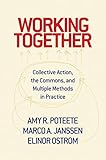Working Together : Collective Action, the Commons, and Multiple Methods in Practice / Elinor Ostrom, Marco A. Janssen, Amy R. Poteete.
Material type: TextPublisher: Princeton, NJ : Princeton University Press, [2010]Copyright date: ©2010Edition: Course BookDescription: 1 online resource (376 p.) : 21 line illus. 8 tablesContent type:
TextPublisher: Princeton, NJ : Princeton University Press, [2010]Copyright date: ©2010Edition: Course BookDescription: 1 online resource (376 p.) : 21 line illus. 8 tablesContent type: - 9780691146041
- 9781400835157
- online - DeGruyter
- Issued also in print.
| Item type | Current library | Call number | URL | Status | Notes | Barcode | |
|---|---|---|---|---|---|---|---|
 eBook
eBook
|
Biblioteca "Angelicum" Pont. Univ. S.Tommaso d'Aquino Nuvola online | online - DeGruyter (Browse shelf(Opens below)) | Online access | Not for loan (Accesso limitato) | Accesso per gli utenti autorizzati / Access for authorized users | (dgr)9781400835157 |
Browsing Biblioteca "Angelicum" Pont. Univ. S.Tommaso d'Aquino shelves, Shelving location: Nuvola online Close shelf browser (Hides shelf browser)

|

|

|

|

|

|

|
||
| online - DeGruyter Forbidden Fruit : Counterfactuals and International Relations / | online - DeGruyter Rational Theory of International Politics : The Logic of Competition and Cooperation / | online - DeGruyter Diversity and Complexity / | online - DeGruyter Working Together : Collective Action, the Commons, and Multiple Methods in Practice / | online - DeGruyter Reds, Whites, and Blues : Social Movements, Folk Music, and Race in the United States / | online - DeGruyter Economic Sociology : A Systematic Inquiry / | online - DeGruyter Orderly Fashion : A Sociology of Markets / |
Frontmatter -- Contents -- List of Illustrations -- List of Tables -- Acknowledgments -- Prologue -- Part One: Introduction -- Chapter One. Overcoming Methodological Challenges -- Part Two: Field Methods -- Chapter Two. Small-N Case Studies: Putting the Commons under a Magnifying Glass -- Chapter Three. Broadly Comparative Field-Based Research -- Chapter Four. Meta-Analysis: Getting the Big Picture through Synthesis -- Chapter Five. Collaborative Field Studies -- Part Three: Models and Experiments in the Laboratory and the Field -- Chapter Six. Experiments in the Laboratory and the Field -- Chapter Seven. Agent-Based Models of Collective Action -- Chapter Eight. Building Empirically Grounded Agent-Based Models -- Part Four: Synthesis -- Chapter Nine. Pushing the Frontiers of the Theory of Collective Action and the Commons -- Appendix 9.1: A Theoretical Puzzle: Why Do Some Resource Users Self-Organize and Others Do Not? -- Chapter Ten. Learning from Multiple Methods -- Notes -- References -- Index
restricted access online access with authorization star
http://purl.org/coar/access_right/c_16ec
Advances in the social sciences have emerged through a variety of research methods: field-based research, laboratory and field experiments, and agent-based models. However, which research method or approach is best suited to a particular inquiry is frequently debated and discussed. Working Together examines how different methods have promoted various theoretical developments related to collective action and the commons, and demonstrates the importance of cross-fertilization involving multimethod research across traditional boundaries. The authors look at why cross-fertilization is difficult to achieve, and they show ways to overcome these challenges through collaboration. The authors provide numerous examples of collaborative, multimethod research related to collective action and the commons. They examine the pros and cons of case studies, meta-analyses, large-N field research, experiments and modeling, and empirically grounded agent-based models, and they consider how these methods contribute to research on collective action for the management of natural resources. Using their findings, the authors outline a revised theory of collective action that includes three elements: individual decision making, microsituational conditions, and features of the broader social-ecological context. Acknowledging the academic incentives that influence and constrain how research is conducted, Working Together reworks the theory of collective action and offers practical solutions for researchers and students across a spectrum of disciplines.
Issued also in print.
Mode of access: Internet via World Wide Web.
In English.
Description based on online resource; title from PDF title page (publisher's Web site, viewed 29. Jul 2021)


